



Some people like making their life more complicated than others. Finding the horse of one's dreams is hard enough, we all have a picture of our dream-horse firmly imprinted in our minds, and spend years trying to find him or her.
When this "picture" doesn't just include conformation and movement, a sweet temperament, a certain size and age - but a specific colour as well it becomes more and more difficult, as you can imagine.
Like most obsessions, my particular love for a horse with pinto (skewbald or piebald) markings crept up on me over the years. It all started many years ago in Germany - when I saw a bay and white horse of unknown breeding among a herd of "plain" coloured horses. he really stood out !
Coloured horses have become terribly popular in many countries over the past 10 years. Before then it was only the odd American horse, or gypsy cobs in Britain that displayed the broken coated markings, and those were generally frowned upon by the "traditionalists". Now I can't take my gelding anywhere without several people coming up to me asking about him. Whilst this is tremendously flattering I can't help but wonder how much of this interest he would provoke had he been born a "plain" bay.
Coloured horses come in endless shapes, sizes and breeds. You will find anything from Shetlands to huge Coldbloods, plus more exotic breeds such as pure Warmbloods , Icelandics or various American breeds.
What those horses have in common is their genetic makeup. The genes which give a horse the distinctive markings are inherited quite separately from the base colour of the coat, so never let anyone tell you that chestnuts are more or less likely to produce a coloured foal than, say, bays.
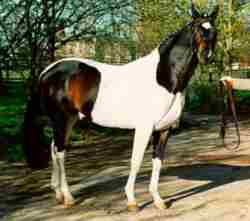 |
| Compared with the Overo the Tobiano looks like paint has been poured over it from above (Figiel - Warmblood Stallion) |
There are several different types of markings, but the 2 most common are the Overo and Tobiano patterns. The Overo is rare outside the Quarterhorse breed,and has a more complicated genetic make-up. The easiest way to tell the two apart is to look at the horse as if it was a plain coloured horse and someone had poured a bucket of paint over it. A Tobiano looks as if the paint had been poured over him from above, letting it run down quite smoothly, then dipped the horse's legs into the remaining paint. The white patches usually cross over the back somewhere, the legs are usually white up to a point, and the headmarkings are limited to "normal" amounts of white such as that found on a solid coloured horse.
An Overo looks like someone had turned the horse upside down and then splashed the paint on from below and the sides. The edges of the markings are more ragged and the heads usually have larger white areas than seen in the Tobiano.
The terms Skewbald and Piebald are English descriptions of coloured horses, A Piebald is black and White, a Skewbald is any other colour and white. To be eligible for registration in Great Britain the horse has to have an area of white on the body above a line between the stifle and the elbow, excluding the head, and larger than 6 square inches in diameter.
We will concentrate mainly on the Tobiano here, it's what most people in Europe mean when they talk of coloured horses, and it is the easiest to breed for and predict.
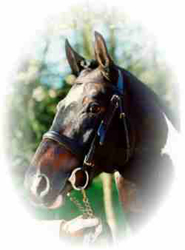 |
| The expressive head of this Warmblood stallion shows the white sclera, often called "Human Eye". This has nothing to do with the white shown by excited and frightened horses! |
Tobianos often have secondary characteristics, such as bi-coloured hoofs, ink-spots (black spots on white legs , and the characteristic white sclera - which must not be confused with the wild-eyed look of an agitated or frightened horse.
The white areas on a coloured horse are also much "whiter" in appearance than the white of a grey, because the underlying skin is colourless, whereas even the whitest greys have black skin underneath. Of course this bright whiteness takes a lot of time to maintain - and if only I had a penny for every time I arrived at the stables before a competition and find that a bay horse might have been so much easier to maintain.
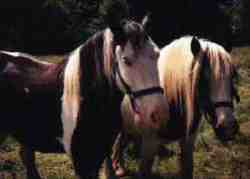 |
| In some European countries so called "Tinker-Ponies" are the very height of fashion and are changing hands at fairly high prices! A Tinker pony is basically a smaller version of a vanner. |
Each Country has it's own way to divide the various types of coloured horses. This is no mean task, as there appears to be just about everything from near Thoroughbred to near Shires, and classifying and, God forbid, judging a class consisting of such varying types is just about a nightmare.
The traditional coloured horse of the British Isles is probably the Vanner and it's smaller version, the coloured cob (or Tinker, as the Germans call it). These were the original "Traveller's" horses, and can still be seen traded by gypsies at places such as the famous Appleby Fair (Editor's note: see next issue of Joy of Horses). Some of those horses fetch astronomical sums after hours of bartering between gypsies, sadly many others end up abandoned at the side of roads or are rounded up by the welfare organisations if they're lucky. The romantic notion of the gypsy caravan with the happy coloured cobs pulling it throughthis green land is sadly a far cry from the reality these days.
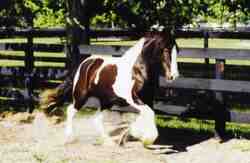 |
| A wonderful image of the Vanner breed, the delightful filly, Esmerelda! Note the impressive feathering. |
In Ireland those heavier types have for years been crossed to Thoroughbred mares - many TB studs keep a number of big coloured Vanner mares, then take the TB foals off their mothers and get them onto the Vanner mares to rear, because the Vanner mares have so much more and higher protein milk. The Vanner foals, who are usually by the stud's teaser-stallion or by young stallions learning their "job"- are usually hand reared and later sold as colourful hunters. The best have the substance of a good middleweight hunter, plenty of movement and jump from the TB, plus an amenable temperament and plenty of good bone from the Vanner. If you cross such an animal with a TB again you end up with Eventers and all round Sports Horses which are becoming increasingly popular.
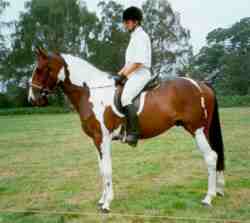 |
| A typical example of the popular cross of TB with colured Irish stock, in this case the author's gelding at the age of four. |
The other type which is growing in popularity is the coloured Warmblood. There are now a whole bunch of coloured Warmbloods in Europe - the best known is probably a Dutch Warmblood called Samber, who is covering a phenomenal number of mares every year, despite his advanced years, and has successful offspring all over the world. Most coloured Warmbloods other than the Polish lines carry some Samber blood in them, and Samber himself was a terrifically successful competition horse in both Dressage and Showjumping.
